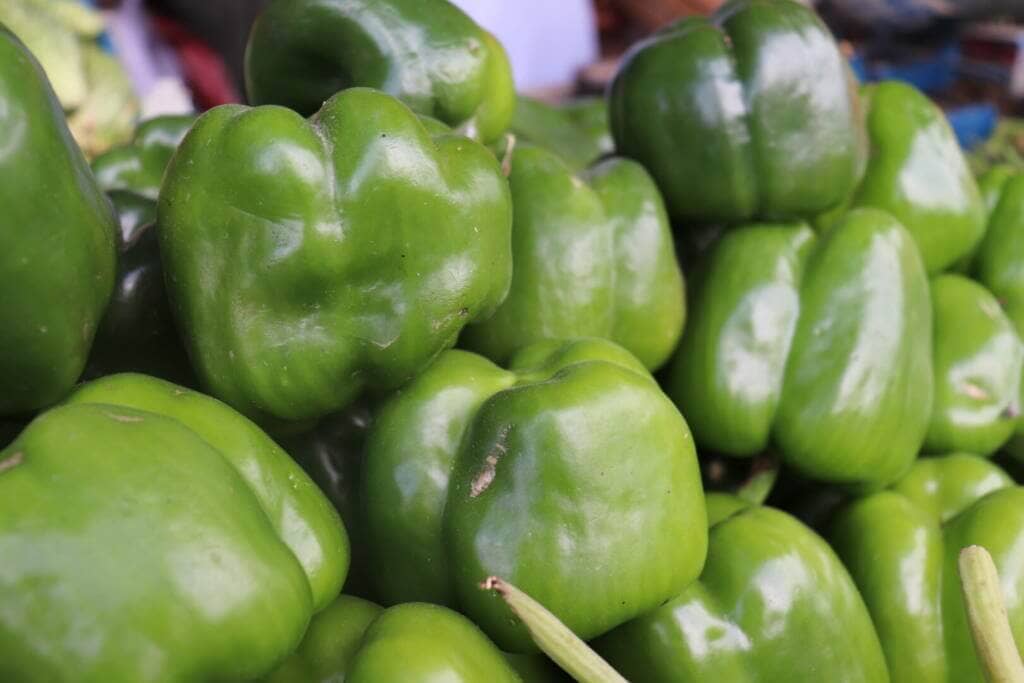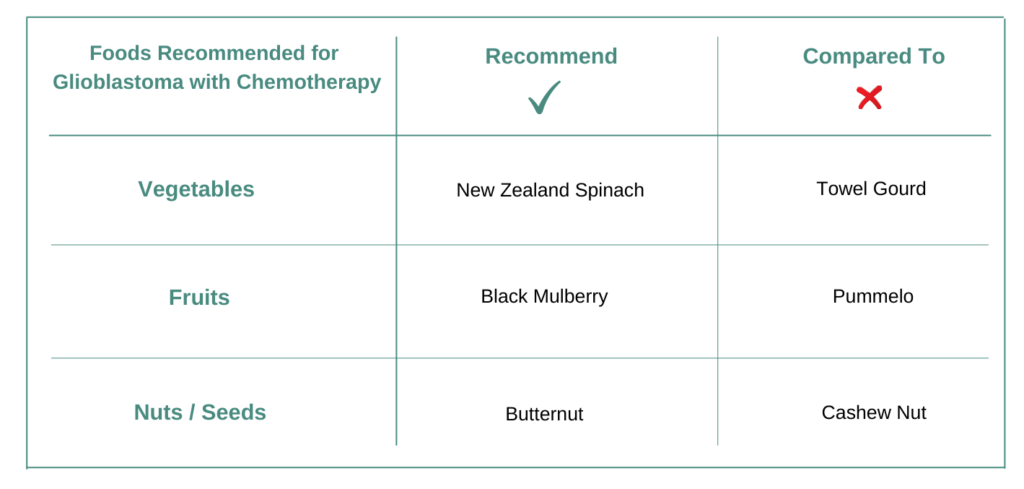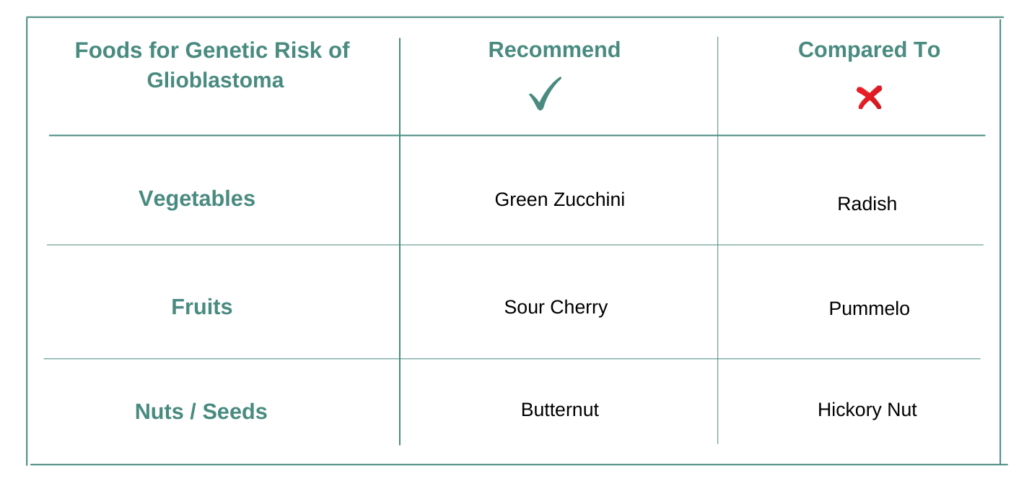Introduction
Foods for Glioblastoma should be personalized for each individual and also must adapt when cancer treatment or tumor genetic change. The personalization and adaptation must consider all the active ingredients or bioactives contained in different foods with respect to cancer tissue biology, genetics, treatments, lifestyle conditions and diet preferences. Hence while nutrition is one of the very important decisions for a cancer patient and individual at risk of cancer to make – how to choose foods to eat is not an easy task.
Glioblastoma is the most common and most malignant of primary brain tumors. Of the estimated 17,000 primary brain tumors diagnosed in the United States each year, 60% are glioblastomas or gliomas, with an incidence of 2-3 new cases per 100,000 people per year. Glioblastomas primarily affect adults, and they are located preferentially in the cerebral hemispheres. These tumors may develop from low-grade astrocytoma or anaplastic astrocytoma, but more frequently they manifest de novo without any evidence of a less malignant precursor lesion. The presenting symptoms for glioblastoma include slowly progressive neurologic deficits such as motor weakness, headache, nausea and vomiting, cognitive impairment, and seizures. Only modest advancements in the treatment of glioblastoma have occurred in the past 25 years. No current treatments are curative and mostly remain palliative, that include surgery, radiotherapy, and chemotherapy, but they have been shown to prolong quality survival to a median survival of approximately 12 months. The 2-year survival rate is 25% and the 5-year survival rate is only 10%. In addition to the treatments, patients with glioblastoma can also be supported with the right personalized nutrition (foods and supplements) aligned with their physician-prescribed treatment and stage of disease, to further enhance their quality of life and survival.
For Glioblastoma does it matter what vegetables, fruits, nuts, seeds one eats?
A very common nutrition question asked by cancer patients and individuals at-genetic risk of cancer is – for cancers like Glioblastoma does it matter what foods I eat and which I do not? Or if I follow a plant-based diet is that enough for cancer like Glioblastoma?
For example does it matter if vegetable New Zealand Spinach is consumed more compared to Towel Gourd? Does it make any difference if fruit Pummelo is preferred over Black Mulberry? Also if similar choices are made for nuts/seeds like Butternut over Cashew Nut and for pulses like Broad Bean over Yardlong Bean. And if what I eat matters – then how does one identify foods which are recommended for Glioblastoma and is it the same answer for everyone with the same diagnosis or genetic risk?
Yes! Foods you eat matters for Glioblastoma!
Food recommendations may not be the same for everyone and can be different even for the same diagnosis and genetic risk.

All foods (vegetables, fruits, nuts, seeds, pulses, oils etc.) and nutritional supplements are made up of more than one active molecular ingredient or bio-actives in different proportions and quantities. Each active ingredient has a unique mechanism of action – which can be activation or inhibition of different biochemical pathways. Simply stated foods and supplements which are recommended are those which do not cause an increase of molecular drivers of cancer but reduce them. Else those foods should not be recommended. Foods contain multiple active ingredients – hence when evaluating foods and supplements you need to consider the impact of all active ingredients cumulatively rather than individually.
For example Pummelo contains active ingredients Quercetin, Curcumin, Isoliquiritigenin, Apigenin, Lycopene. And Black Mulberry contains active ingredients Quercetin, Curcumin, Isoliquiritigenin, Apigenin, Myricetin and possibly others.
A common mistake made when deciding and choosing foods to eat for Glioblastoma – is to evaluate only selected active ingredients contained in foods and ignore the rest. Because different active ingredients contained in foods may have opposing effects on cancer drivers – you cannot cherry pick active ingredients in foods and supplements for making a nutrition decision for Glioblastoma.
YES – FOOD CHOICES MATTER FOR CANCER. NUTRITION DECISIONS MUST CONSIDER ALL ACTIVE INGREDIENTS OF FOODS.
Skills Needed for Nutrition Personalization for Glioblastoma?
Personalized nutrition for cancers like Glioblastoma consists of recommended foods / supplements; not recommended foods / supplements with example recipes which prioritize use of recommended foods. An example of personalized nutrition can be seen at this link.
Deciding which foods are recommended or not is extremely complicated, requiring expertise in Glioblastoma biology, food science, genetics, biochemistry along with good understanding of how cancer treatments work and associated vulnerabilities by which the treatments could stop being effective.
MINIMUM KNOWLEDGE EXPERTISE NEEDED FOR NUTRITION PERSONALIZATION FOR CANCER ARE: CANCER BIOLOGY, FOOD SCIENCE, CANCER TREATMENTS AND GENETICS.
Foods to Eat After Cancer Diagnosis!
No two cancers are the same. Go beyond the common nutrition guidelines for everyone and make personalized decisions about food and supplements with confidence.
Characteristics of cancers like Glioblastoma
All cancers like Glioblastoma can be characterized by a unique set of biochemical pathways – the signature pathways of Glioblastoma. Biochemical pathways like DNA Repair, Angiogenesis, PI3K-AKT-MTOR Signaling, MAPK Signaling are part of the signature definition of Glioblastoma. Each individual’s cancer genetics can be different and hence their specific cancer signature could be unique.
The treatments which are effective for Glioblastoma need to be cognizant of the associated signature biochemical pathways for each cancer patient and individual at genetic risk. Therefore different treatments with different mechanisms of actions are effective for different patients. Similarly and for the same reasons foods and supplements need to be personalized for each individual. Hence some foods and supplements are recommended for Glioblastoma when taking cancer treatment Temozolomide, and some foods and supplements are not recommended.
Sources like cBioPortal and many others provide population representative patient anonymized data from clinical trials for all cancer indications. This data consists of clinical trial study details like sample size / number of patients, age groups, gender, ethnicity, treatments, tumor site and any genetic mutations.
TP53, PTEN, LAMA1, MUC4 and HLA-DRB1 are the top ranked reported genes for Glioblastoma. TP53 is reported in 2.1 % of the representative patients across all clinical trials. And PTEN is reported in 1.8 %. The combined population patient data cover ages from 3 to 90. 61.3 % of the patient data are identified as men. The Glioblastoma biology along with reported genetics together define the population represented signature biochemical pathways for this cancer. If the individual cancer tumor genetics or genes contributing to the risk are also known then that should also be used for nutrition personalization.
NUTRITION CHOICES SHOULD MATCH WITH EACH INDIVIDUAL’S CANCER SIGNATURE.
Food and Supplements for Glioblastoma
For Cancer Patients
Cancer patients on treatment or on palliative care need to make decisions on food and supplements – for the needed dietary calories, for managing any treatment side effects and also for improved cancer management. All plant-based foods are not equal and choosing and prioritizing foods which are personalized and customized to ongoing cancer treatment is important and complicated. Here are some examples providing guidelines for making nutrition decisions.
Choose Vegetable NEW ZEALAND SPINACH or TOWEL GOURD?
Vegetable New Zealand Spinach contains many active ingredients or bioactives such as Quercetin, Curcumin, Isoliquiritigenin, Apigenin, Myricetin. These active ingredients manipulate various biochemical pathways like Microtubule Dynamics, Hypoxia, NFKB Signaling and PI3K-AKT-MTOR Signaling and others. New Zealand Spinach is recommended for Glioblastoma when ongoing cancer treatment is Temozolomide. This is because New Zealand Spinach modifies those biochemical pathways which have been scientifically reported to sensitize the effect of Temozolomide.
Some of the active ingredients or bioactives in vegetable Towel Gourd are Curcumin, Isoliquiritigenin, Apigenin, Lycopene, Phloretin. These active ingredients manipulate various biochemical pathways like MAPK Signaling, Autophagy, Notch Signaling and Direct Repair and others. Towel Gourd is not recommended for Glioblastoma when ongoing cancer treatment is Temozolomide because it modifies those biochemical pathways which make the cancer treatment resistant or less responsive.
VEGETABLE NEW ZEALAND SPINACH IS RECOMMENDED OVER TOWEL GOURD FOR Glioblastoma AND TREATMENT Temozolomide.
Choose Fruit BLACK MULBERRY or PUMMELO?
Fruit Black Mulberry contains many active ingredients or bioactives such as Quercetin, Curcumin, Isoliquiritigenin, Apigenin, Myricetin. These active ingredients manipulate various biochemical pathways like MAPK Signaling, DNA Repair, Epithelial to Mesenchymal Transition and Cell Survival and others. Black Mulberry is recommended for Glioblastoma when ongoing cancer treatment is Temozolomide. This is because Black Mulberry modifies those biochemical pathways which have been scientifically reported to sensitize the effect of Temozolomide.
Some of the active ingredients or bioactives in fruit Pummelo are Quercetin, Curcumin, Isoliquiritigenin, Apigenin, Lycopene. These active ingredients manipulate various biochemical pathways like DNA Repair and Oxidative Stress and others. Pummelo is not recommended for Glioblastoma when ongoing cancer treatment is Temozolomide because it modifies those biochemical pathways which make the cancer treatment resistant or less responsive.
FRUIT BLACK MULBERRY IS RECOMMENDED OVER PUMMELO FOR Glioblastoma AND TREATMENT Temozolomide.
Choose Nut BUTTERNUT or CASHEW NUT?
Butternut contains many active ingredients or bioactives such as Curcumin, Isoliquiritigenin, Apigenin, Myricetin, Lycopene. These active ingredients manipulate various biochemical pathways like Microtubule Dynamics, Hypoxia, NFKB Signaling and PI3K-AKT-MTOR Signaling and others. Butternut is recommended for Glioblastoma when ongoing cancer treatment is Temozolomide. This is because Butternut modifies those biochemical pathways which have been scientifically reported to sensitize the effect of Temozolomide.
Some of the active ingredients or bioactives in Cashew Nut are Quercetin, Curcumin, Isoliquiritigenin, Myricetin, Phloretin. These active ingredients manipulate various biochemical pathways like Autophagy, Interferon Signaling and Direct Repair and others. Cashew Nut is not recommended for Glioblastoma when ongoing cancer treatment is Temozolomide because it modifies those biochemical pathways which make the cancer treatment resistant or less responsive.
BUTTERNUT IS RECOMMENDED OVER CASHEW NUT FOR Glioblastoma AND TREATMENT Temozolomide.

For Individuals with Genetic Risk of Cancer
The question asked by individuals who have genetic risk of Glioblastoma or familial history is “What Should I Eat Differently from Before?” and how they should choose foods and supplements to manage risks of the disease. Since for cancer risk there is nothing actionable in terms of treatment – decisions of foods and supplements become important and one of the very few actionable things which can be done. All plant-based foods are not equal and based on identified genetics and pathway signature – the choices of food and supplements should be personalized.
Choose Vegetable GIANT BUTTERBUR or TURNIP?
Vegetable Giant Butterbur contains many active ingredients or bioactives such as Apigenin, Curcumin, Lupeol, Myricetin, Daidzein. These active ingredients manipulate various biochemical pathways like MAPK Signaling, Cell Cycle Checkpoints, Stem Cell Signaling and Focal Adhesion and others. Giant Butterbur is recommended for risk of Glioblastoma when associated genetic risk is HLA-DRB1. This is because Giant Butterbur increases those biochemical pathways which counteract the signature drivers of it.
Some of the active ingredients or bioactives in vegetable Turnip are Curcumin, Ellagic Acid, Quercetin, Lupeol, Daidzein. These active ingredients manipulate various biochemical pathways like Stem Cell Signaling and Focal Adhesion and others. Turnip is not recommended when risk of Glioblastoma when associated genetic risk is HLA-DRB1 because it increases the signature pathways of it.
VEGETABLE GIANT BUTTERBUR IS RECOMMENDED OVER TURNIP FOR HLA-DRB1 GENETIC RISK OF CANCER.
Choose Fruit NANCE or LOGANBERRY?
Fruit Nance contains many active ingredients or bioactives such as Apigenin, Curcumin, Lupeol, Myricetin, Daidzein. These active ingredients manipulate various biochemical pathways like MAPK Signaling, Cell Cycle Checkpoints, Stem Cell Signaling and Focal Adhesion and others. Nance is recommended for risk of Glioblastoma when associated genetic risk is HLA-DRB1. This is because Nance increases those biochemical pathways which counteract the signature drivers of it.
Some of the active ingredients or bioactives in fruit Loganberry are Apigenin, Curcumin, Lupeol, Myricetin, Daidzein. These active ingredients manipulate various biochemical pathways like Insulin Signaling and Stem Cell Signaling and others. Loganberry is not recommended when risk of Glioblastoma when associated genetic risk is HLA-DRB1 because it increases the signature pathways of it.
FRUIT NANCE IS RECOMMENDED OVER LOGANBERRY FOR HLA-DRB1 GENETIC RISK OF CANCER.
Choose Nut COMMON WALNUT or EUROPEAN CHESTNUT?
Common Walnut contains many active ingredients or bioactives such as Curcumin, Ellagic Acid, Quercetin, Lupeol, Myricetin. These active ingredients manipulate various biochemical pathways like MAPK Signaling, Insulin Signaling and Focal Adhesion and others. Common Walnut is recommended for risk of Glioblastoma when associated genetic risk is HLA-DRB1. This is because Common Walnut increases those biochemical pathways which counteract the signature drivers of it.
Some of the active ingredients or bioactives in European Chestnut are Apigenin, Curcumin, Ellagic Acid, Quercetin, Lupeol. These active ingredients manipulate various biochemical pathways like Insulin Signaling and Stem Cell Signaling and others. European Chestnut is not recommended when risk of Glioblastoma when associated genetic risk is HLA-DRB1 because it increases the signature pathways of it.
COMMON WALNUT IS RECOMMENDED OVER EUROPEAN CHESTNUT FOR HLA-DRB1 GENETIC RISK OF CANCER.

In Conclusion
Foods and Supplements chosen are important decisions for cancers like Glioblastoma. Glioblastoma patients and individuals with genetic-risk always have this question: “What foods and nutritional supplements are recommended for me and which are not?” There is a common belief which is a misconception that all plant-based foods could be beneficial or not but would not be harmful. Certain foods and supplements can interfere with cancer treatments or promote molecular pathway drivers of cancer.
There are different types of cancer indications like Glioblastoma, each with different tumor genetics with further genomic variations across each individual. Further every cancer treatment and chemotherapy has a unique mechanism of action. Each food like New Zealand Spinach contains various bioactives in different quantities, which have an impact on different and distinct sets of biochemical pathways. The definition of personalized nutrition is individualized food recommendations for the cancer indication, treatments, genetics, lifestyle and other factors. Nutrition personalization decisions for cancer require knowledge of cancer biology, food science and an understanding of different chemotherapy treatments. Finally when there are treatment changes or new genomics is identified – the nutrition personalization needs re-evaluation.
The addon nutrition personalization solution makes the decision making easy and removes all the guesswork in answering the question, “What foods should I choose or not choose for Glioblastoma?”. The addon multi-disciplinary team includes cancer physicians, clinical scientists, software engineers and data scientists.
Personalized Nutrition for Cancer!
Cancer changes with time. Customize and modify your nutrition based on cancer indication, treatments, lifestyle, food preferences, allergies and other factors.
References
- Pancan Pcawg 2020
- Effects of isoliquiritigenin on ovarian cancer cells.
- Intake of mulberry 1-deoxynojirimycin prevents colorectal cancer in mice.
- The citrus flavonoid naringenin stimulates DNA repair in prostate cancer cells.
- Growth stimulation of human pulmonary adenocarcinoma cells and small airway epithelial cells by beta-carotene via activation of cAMP, PKA, CREB and ERK1/2.
- Dietary D-glucarate effects on the biomarkers of inflammation during early post-initiation stages of benzo[a]pyrene-induced lung tumorigenesis in A/J mice.
- Research progress on the anticancer effects of vitamin K2.
- Negative regulation of signal transducer and activator of transcription-3 signalling cascade by lupeol inhibits growth and induces apoptosis in hepatocellular carcinoma cells.
- https://emedicine.medscape.com/article/283252-overview#a1
